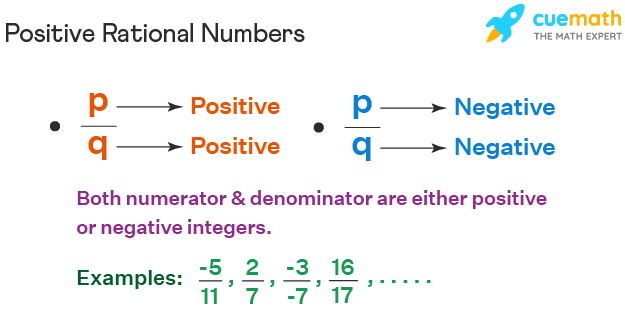Positive Rational Numbers
Positive rational numbers are the numbers for which both the numerator and the denominator are either positive integers or negative integers. In other words, a rational number is positive if both numerator and denominator have the same sign. In this lesson, let's learn about positive rational numbers in detail.
| 1. | What are Positive Rational Numbers? |
| 2. | Positive Rational Numbers Symbols |
| 3. | Positive Rational Numbers Less Than 1 |
| 4. | Reciprocal of a Positive Rational Number |
| 5. | FAQs on Positive Rational Numbers |
What are Positive Rational Numbers?
Positive rational numbers refer to rational numbers when their numerators and denominators are both positive or both negative. Examples of positive rational numbers are 3/8, 9/10, -34/-40, etc. On the other hand, there are negative rational numbers that have opposite signs in numerator and denominator, such as -4/15, 5/-6, -17/19, etc.

Positive Rational Number vs Negative Rational Number
Given below are the points of differences between a positive and a negative rational number,
| Positive Rational Number | Negative Rational Number |
|---|---|
| Both numerator and denominator have the same signs. | Both numerator and denominator have opposite signs. |
| Examples - 3/4, 6/7, 8/11, etc | Examples - -3/4, -6/7, -8/11, etc |
| Numbers greater than 0. | Numbers less than 0. |
| Represented to the right of 0 on the number line. | Represented to the left of 0 on the number line. |
Positive Rational Numbers Symbol
We know that the set of rational numbers is denoted by the symbol Q. Rational numbers are classified as positive, zero, or negative rational numbers. Positive rational numbers are characterized as having the same signs for the numerator and denominator, either both are positive or both are negative.
Positive Rational Numbers Less Than 1
The positive rational numbers less than 1 are as follows: 1/9=0.11, 1/8=0.12, 1/7=0.14, 1/6=0.16, 1/5=0.2, 1/4=0.25, 1/3=0.33, 1/2=0.5, 2/7=0.28, 2/5=0.4, 2/3=0.66, 3/7=0.42, 3/5=0.6, 3/4=0.75, 4/5=0.8, etc.
The above 15 positive rational numbers are the numbers that have values less than 1 and also, the sum of the numerator and denominator does not exceed 10.
Reciprocal of a Positive Rational Number
The reciprocal of a positive rational number is positive only. According to the reciprocal definition, the reciprocal of a number refers to the expression which when multiplied by the number gives the product as 1. In other words, when the product of two numbers is 1, they are said to be reciprocals of each other. The reciprocal of a positive rational number is thus positive only.
Related Articles
Check out a few more interesting articles related to positive rational numbers.
Positive Rational Numbers Examples
-
Example 1: Determine if 7 is a positive rational number.
Solution:
7 can be expressed in the form of a ratio, such that, 7 = 7/1, where both numerator and denominator, i.e. 7 and 1 are positive integers.
Therefore, 7 is a positive rational number.
-
Example 2: Is -31/-51 a positive or negative rational number?
Solution:
Both numerator and denominator have negative signs. Thus, we can multiply and divide both top and bottom of rational numbers by -1, to get (-31/-51) x (-1/-1) = 31/51.
Therefore, -3/-5 is a positive rational number.

FAQs on Positive Rational Numbers
Which Numbers Are Positive Rational Numbers?
A rational number is positive if its numerator and denominator have the same signs(either both are positive or both are negative). 1/4, 2/9, -7/-11, -3/-13, 5/12 are positive rationals, whereas 2/-5, -3/10, -4/7, 11/-23 are not positive rational numbers..
What Is True About Adding Two Rational Numbers That Are Positive?
The sum of two rational numbers is a rational number only. Adding two rationals follows the same procedure as adding two such fractions, resulting in another fraction of this same form. Thus, adding two rational numbers produces another rational number.
Is 7/8 a positive rational number?
7/8 is a ratio of whole numbers having numerator and denominator both carrying positive signs and thus, is considered as a positive rational number.
Is Zero a Positive Rational Number?
The number 0 is neither a positive nor a negative rational number. A rational number in its standard form has a denominator as a positive integer and the numerator and denominator have no common factor other than 1.
What Are Positive and Negative Rational Numbers?
Rational numbers are classified as positive, zero, or negative rational numbers. A rational number is said to be positive if the numerator and denominator both are positive integers or both are negative integers whereas, a rational number is considered negative if either the numerator or the denominator is a negative integer.
How To Multiply Positive Rational Numbers?
The product of two given fractions is a fraction whose numerator is the product of the numerators of the given fractions and whose denominator is the product of the denominators of the given fractions. We follow the same rule for the product of rational numbers. Therefore, the product of two rational numbers equals the product of their numerators/product of their denominators. Thus, if a/b and c/d are any two rational numbers, then a/b × c/d = a × c/b × d.
How To Multiply Positive and Negative Rational Numbers?
Multiplication of a positive and a negative rational number is the same as multiplying fractions. The rules for multiplication are simple.
- If both numbers are positive, the result is positive.
- If both numbers are negative, the result is positive.
- If one of the rational numbers is negative, the result will be negative.
visual curriculum
